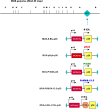Optimization in the expression of ASFV proteins for the development of subunit vaccines using poxviruses as delivery vectors
- PMID: 34873256
- PMCID: PMC8648923
- DOI: 10.1038/s41598-021-02949-x
Optimization in the expression of ASFV proteins for the development of subunit vaccines using poxviruses as delivery vectors
Abstract
African swine fever virus (ASFV) causes a highly contagious hemorrhagic disease that affects domestic pig and Eurasian wild boar populations. To date, no safe and efficacious treatment or vaccine against ASF is available. Nevertheless, there are several reports of protection elicited by experimental vaccines based on live attenuated ASFV and some levels of protection and reduced viremia in other approaches such as DNA, adenovirus, baculovirus, and vaccinia-based vaccines. Current ASF subunit vaccine research focuses mainly on delivering protective antigens and antigen discovery within the ASFV genome. However, due to the complex nature of ASFV, expression vectors need to be optimized to improve their immunogenicity. Therefore, in the present study, we constructed several recombinant MVA vectors to evaluate the efficiency of different promoters and secretory signal sequences in the expression and immunogenicity of the p30 protein from ASFV. Overall, the natural poxvirus PrMVA13.5L promoter induced high levels of both p30 mRNA and specific anti-p30 antibodies in mice. In contrast, the synthetic PrS5E promoter and the S E/L promoter linked to a secretory signal showed lower mRNA levels and antibodies. These findings indicate that promoter selection may be as crucial as the antigen used to develop ASFV subunit vaccines using MVA as the delivery vector.
© 2021. The Author(s).
Conflict of interest statement
The authors declare no competing interests.
Figures







Similar articles
-
BacMam immunization partially protects pigs against sublethal challenge with African swine fever virus.Antiviral Res. 2013 Apr;98(1):61-5. doi: 10.1016/j.antiviral.2013.02.005. Epub 2013 Feb 18. Antiviral Res. 2013. PMID: 23428670
-
The recombinant pseudorabies virus expressing African swine fever virus CD2v protein is safe and effective in mice.Virol J. 2020 Nov 16;17(1):180. doi: 10.1186/s12985-020-01450-7. Virol J. 2020. PMID: 33198749 Free PMC article.
-
Simultaneous Deletion of the 9GL and UK Genes from the African Swine Fever Virus Georgia 2007 Isolate Offers Increased Safety and Protection against Homologous Challenge.J Virol. 2016 Dec 16;91(1):e01760-16. doi: 10.1128/JVI.01760-16. Print 2017 Jan 1. J Virol. 2016. PMID: 27795430 Free PMC article.
-
African Swine Fever Vaccinology: The Biological Challenges from Immunological Perspectives.Viruses. 2022 Sep 13;14(9):2021. doi: 10.3390/v14092021. Viruses. 2022. PMID: 36146827 Free PMC article. Review.
-
Recent progress and major gaps in the vaccine development for African swine fever.Braz J Microbiol. 2024 Mar;55(1):997-1010. doi: 10.1007/s42770-024-01264-7. Epub 2024 Feb 5. Braz J Microbiol. 2024. PMID: 38311710 Free PMC article. Review.
Cited by
-
Vaccines for African swine fever: an update.Front Microbiol. 2023 Apr 27;14:1139494. doi: 10.3389/fmicb.2023.1139494. eCollection 2023. Front Microbiol. 2023. PMID: 37180260 Free PMC article. Review.
-
Progress in African Swine Fever Vector Vaccine Development.Int J Mol Sci. 2025 Jan 22;26(3):921. doi: 10.3390/ijms26030921. Int J Mol Sci. 2025. PMID: 39940691 Free PMC article. Review.
-
Low-host double MDA workflow for uncultured ASFV positive blood and serum sample sequencing.Front Vet Sci. 2022 Sep 20;9:936781. doi: 10.3389/fvets.2022.936781. eCollection 2022. Front Vet Sci. 2022. PMID: 36204298 Free PMC article.
-
Evaluation of the Immunogenicity of a Pool of Recombinant Lactococcus lactis Expressing Eight Antigens of African Swine Fever Virus in a Mouse Model.Vet Sci. 2025 Feb 7;12(2):140. doi: 10.3390/vetsci12020140. Vet Sci. 2025. PMID: 40005900 Free PMC article.
-
Orally administered recombinant Lactobacillus expressing African swine fever virus antigens that induced immunity responses.Front Microbiol. 2023 Jan 9;13:1103327. doi: 10.3389/fmicb.2022.1103327. eCollection 2022. Front Microbiol. 2023. PMID: 36699597 Free PMC article.
References
-
- Parker J, Plowright W, Pierce MA. The epizootiology of African swine fever in Africa. Vet. Rec. 1969;85:668–674. - PubMed
-
- Tulman ER, Delhon GA, Ku BK, Rock DL. Current Topics in Microbiology and Immunology. Springer; 2009. African swine fever virus; pp. 43–87. - PubMed
-
- Hamdy FM, Dardiri AH. Clinical and immunologic responses of pigs to African swine fever virus isolated from the Western Hemisphere. Am. J. Vet. Res. 1984;45:711–714. - PubMed
-
- Mebus CA, Dardiri AH. Western hemisphere isolates of African swine fever virus: Asymptomatic carriers and resistance to challenge inoculation. Am. J. Vet. Res. 1980;41:1867–1869. - PubMed
Publication types
MeSH terms
Substances
LinkOut - more resources
Full Text Sources

